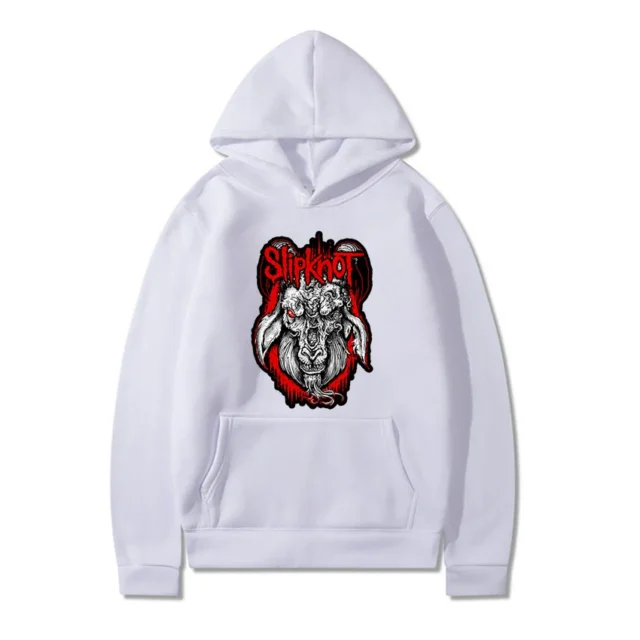Slipknot shirts have become far more than just merchandise — they represent a cultural movement, a fan’s identity, and a badge of loyalty to one of metal’s most iconic bands. slipknotmerchshop.com From the late 1990s to today, Slipknot’s merchandise, especially their T-shirts, has held a unique place in the hearts and wardrobes of heavy music fans around the world. Combining striking imagery, dark themes, and bold statements, Slipknot shirts are as intense and unrelenting as the band itself.
The Origins of Slipknot Merchandise
Slipknot was formed in Des Moines, Iowa, in 1995. slipknot shoes By the time their self-titled album was released in 1999 under Roadrunner Records, the band had already cultivated a distinctive visual identity — characterized by numbered members, eerie masks, and jumpsuits. This theatrical presence quickly extended to their merchandise.
Slipknot shirts were among the earliest ways fans could publicly align themselves with the band’s aggressive, no-holds-barred ethos. In the pre-social media age, donning a Slipknot T-shirt was a way of broadcasting your allegiance and musical taste. Much like wearing a Metallica, Slayer, or Korn shirt, a Slipknot shirt was a symbol of rebellion and individuality.
Iconic Designs Through the Years
Slipknot’s shirts are known for their haunting graphics, band member masks, and lyrical quotes. Over the years, the designs have evolved but retained a few common themes: darkness, chaos, and identity.
Early 2000s Era Shirts
These featured chaotic, graffiti-style artwork, often incorporating the tribal “S” logo, demonic imagery, and the masks of each band member. The shirts were typically black — a staple color in metal fashion — with red, white, or gray print.Iowa” and “Vol. 3” Era
As Slipknot’s sound evolved, so did their merchandise. During the Iowa (2001) era, shirts became even darker and more brutal, with blood splatters, inverted crosses, and disturbing visuals. With Vol. 3: (The Subliminal Verses) (2004), a more experimental album, the shirts featured more intricate designs, often combining gothic fonts with abstract imagesModern Designs (Post-2010s)
Recent Slipknot shirts incorporate high-resolution graphics, sometimes mixing photography with digital art. Designs include the “Nonagram” (nine-pointed star), images from music videos, and artwork from albums like We Are Not Your Kind (2019) and The End, So Far (2022). These shirts tend to balance nostalgia for the old-school fans with modern aesthetics that attract new listeners.
Cultural Significance
Wearing a Slipknot shirt isn’t just about showing support for a band — it’s about connecting with a community. Metal fans are known for their loyalty and passion, and Slipknot fans (known as “Maggots”) are among the most dedicated. A Slipknot shirt often serves as a conversation starter, a way to identify like-minded individuals in a crowd.
In many ways, Slipknot shirts also serve as symbols of resistance. The band’s lyrics often address alienation, rage, and inner struggle — themes that resonate deeply with those who feel misunderstood or rejected by mainstream society. Wearing a Slipknot shirt can be an act of defiance, a way of saying: “I don’t fit into your mold, and I’m proud of it.”
Collectibility and Rarity
As with many bands with a long career, older Slipknot shirts have become collector’s items. Vintage tees from the Iowa tour or Ozzfest 1999 can fetch high prices on resale platforms like eBay, Depop, or Grailed. Fans seek out rare prints, misprints, and original tour merchandise. In some cases, limited edition drops or collaborations with artists or brands have become highly coveted.
Some collectors even hunt for region-specific tour shirts — for instance, a Slipknot shirt sold only at a Tokyo concert in 2001 might be prized for its rarity and unique artwork.
Slipknot Shirts in Fashion and Streetwear
Interestingly, Slipknot shirts have also crossed over into street fashion. In recent years, celebrities and influencers have been spotted wearing vintage metal tees, including Slipknot. High-end fashion designers have even incorporated metal and punk aesthetics into their lines.
This blending of music and fashion has reignited interest in Slipknot shirts among people who may not be hardcore fans of the band, but appreciate the edgy, graphic-heavy aesthetic. While this can be controversial within the fanbase — with some accusing outsiders of “posing” — it’s also a testament to Slipknot’s wide-reaching influence.
Where to Buy Slipknot Shirts
Slipknot shirts are available through multiple channels:
Official Store: The band’s website often carries the latest and most authentic merchandise, including exclusive releases.Tour Merch Booths: Shirts sold during live concerts are often unique and marked with the tour date/city.Retail Chains: Stores like Hot Topic, EMP, and Rockabilia frequently stock Slipknot apparel.Online Marketplaces: Sites like Etsy, eBay, and Depop offer a wide range of new and vintage shirts — but buyers should beware of bootlegs.Collaborations: Slipknot has teamed up with brands like Supreme, Hypland, and others for limited-edition drops that blend streetwear with metal culture.
How to Style a Slipknot Shirt
Styling a Slipknot shirt depends on your personal taste. Here are a few common looks:
Classic Metalhead Look: Pair it with black jeans, combat boots, a leather jacket, and chain accessories.Grunge-Inspired: Layer over a flannel shirt, distressed jeans, and Converse.Streetwear Hybrid: Tuck a vintage Slipknot shirt into cargo pants with sneakers and a beanie for a modern edge.Festival Fit: Add ripped shorts, fishnets, and dark makeup for a bold concert look.
Regardless of the style, the shirt remains the centerpiece — bold, gritty, and unapologetic.
Final Thoughts
Slipknot shirts aren’t just pieces of cotton and ink — they’re powerful cultural artifacts. They represent defiance, community, and a connection to one of the most visually and musically intense bands in modern metal history. Whether you’re a lifelong Maggot or a new fan, wearing a Slipknot shirt is about more than fashion — it’s about embracing chaos, individuality, and the enduring legacy of a band that refuses to be tamed.







